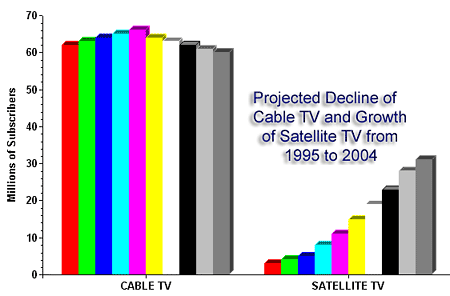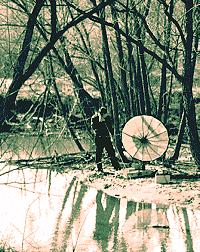|
Film, Radio and TV - 29 |
If
an illustration does not appear at first, it may be necessary to reload
the page.
Cable and Satellite TV Services
In 1950, CATV, or community antenna television, was born in a small town in near Philadelphia, Pennsylvania. An appliance dealer living in Lansford, some 80 miles away, was having trouble selling TV sets because of poor reception in his area. He reasoned that he could sell more TV sets if he put up a tall antenna in his community to pick up the TV stations from Philadelphia. (Recall from Module 17 that TV signals are line-of-sight and are blocked by mountains and tall structures.) Using coaxial cable lines, he distributed the TV signals
from his antenna But "cable" not only imports distant signals. Viewers in large cities, where TV signals are very strong, often have problems with ghosts, or multiple images in their pictures. (Note the TV tower construction photo on right.) You may recall that ghosts--at least the TV kind--are caused by multi-path reception, or receiving multiple TV signals after they bounce off of tall structures in the immediate area. (Note illustration below.) To address this problem, AT&T started installing intercity coaxial cable, in 1952. Today, CATV, or cable services include not only area TV stations, but dozens of other programming services. The latter include FM radio, and movie and special interest channels from satellites. Many cable companies produce their own programs to serve local needs and interests.
Most CATV signals are still sent to homes by coaxial cable. On the right you can see a standard coax connector and (to the left of it) a Note the central wire is surrounded by a white electrical insulator. This in turn is surrounded by braided wire and metal foil shielding. This shielding serves to both confine the internal signal to the cable, and keep external RF (Radio Frequency) energy from nearby appliances from interfering with the signal. Although coaxial cable has been used for decades to conduct TV signals, it has a number of problems. Topping that list is the need to constantly re-amplify signals (with the various problems that introduces) as they are sent through cables. You often see CATV cables and amplifiers attached to utility poles. |
|
The medium that is now slowly taking over from coaxial cable The medium of transmission is light. Light waves have an extremely high frequency and travel at 300,000-km (186,000-miles) per second. A single OF cable can theoretically carry trillions of bits of information every second. The thickness of an optical fiber is only slightly larger than a human hair. The photo on the right shows a light-conducting OF strand going through the eye of a needle. Fiber optic cables normally carry numerous OF strands within a single enclosure. Compared to coaxial cable, optical fiber has ten advantages:
As cable and telephone companies continue to move toward optical fiber, eventually, even home-to-home video transmissions will become as simple as dialing the right number. Satellites hovering about 36,000-kilometers (22,500-miles) above the earth relay most television programming to world viewers. Each satellite or "bird" is composed of a number of transponders, or independent receive-transmit units.
The reflector dish of a ground station uplink is shaped like a parabola, which is similar to the reflector of a powerful searchlight--the kind that can send a beam of light into the night sky. Signals reflected from the center element will hit the dish and then be sent upward on their 36,000-kilometer (22,500-mile) path to the satellite.
As illustrated on the right, once the signal is received, it is amplified, the frequency is changed, and then it is sent back to the earth. The "footprint" (coverage area) of the returning signal covers many thousands of square meters or miles of the earth's surface.
The signal from the satellite is collected in a dish and directed toward a receiving element, as shown on the right. This signal is then amplified thousands of times and fed to your TV receiver.
Networks and TV production facilities routinely distribute their programming via satellite. This is typically how TV productions originating in the Los Angeles-Hollywood area Once they arrive on the East Coast, they are recorded, commercials are typically added, the programs is scheduled into the network agenda, and then beamed back up to satellites at intervals appropriate to the time zones across North America. When the network-to-affiliate link is not being used to relay regular programming, it's used to send news stories, program promotion segments, and other broadcast-related segments to affiliated stations. Stations not affiliated with a network can receive news and information from satellite services such as CNN. Cable (CATV) companies also receive much of their programming from satellites. This includes both TV and audio services. Many TV and audio services (satellite "stations") are not broadcast over the airwaves, but are only available directly from satellites. Satellite-to-Home Services For people living in rural areas out of the range of local TV and CATV/cable services, a satellite receiver may be the only way they can view TV. Home satellite receivers can be cheaper in the long run than CATV/cable services, and they open the door to hundreds of TV and audio channels. There are two basic divisions of satellite services: those that use the C-band and Ku-bands, and subscription services such as the Dish Network, Direct-TV, and VOOM, the HDTV network. The latter services have seen a steady growth rate over the last few years. At the same time the number of cable-TV subscribers is declining. If the present rate of decline and growth continues through the year 2004, the following pattern will emerge.
Satellite-to-home services, such as Direct-TV, have their own satellites and home receiver systems. Unlike the C-band and Ku-band services, once you acquire this type of receiver and receiving dish, you are locked into the particular service--and the monthly subscription fees that go along with it. Although many C- and Ku-band satellite services are subscription based, there are several hundred free TV services ("stations") available. These include:
Even with the dozens of channels of free programming, the C-band and Ku band services have been declining in popularity. This is primarily because of the large dishes involved and the difficulties in finding the programming you are interested in on the dozens of satellites involved. Although much of the programming on C- and KU-bands is free, there are many scrambled satellite services, which means it's encrypted and only available by paid subscription. Pay-per-view movie channels, adult channels, and many on-air regional TV stations (often called superstations) work in this way. Once fees are paid, the unique identifying number in your satellite receiver is uplinked along with the TV satellite signal. This unlocks (unscrambles) the signal so it can be displayed on your TV set. C-band satellites, which typically carry 24 TV channels, have names such as Galaxy 9, Satcom C3 and Morelos 2. For example, the Florida Sunshine Network is on Satcom C1, Channel 24. Although most satellite TV programming is in English, Spanish or French, C- and Ku-band satellite programming is also available in dozens of other languages.
Much of the world can receive FTA (Free to Air) digital broadcasts in the Ku band. This service works much like Direct TV and Dish, except the programming is not scrambled and is free. This service allows users to install small (18-inch) dishes and inexpensive receivers (under $200) to pick up the programming. One of the main attractions to FTA program providers is that multiple digital TV services can be placed in the same space (bandwidth) as one analog satellite TV channel--thus greatly reducing programming distribution costs.
A single C-band or Ku-band satellite channel is capable of carrying both a TV signal and one or more separate audio channels. Taking advantage of this fact are more than 100 free audio services, most in stereo and many without commercials. Some are standard radio stations that also distribute their signal by satellite. Examples are CBM-AM in Quebec and WQXR-FM in New York. Others, which cover everything from classical to hard rock music, are music services available only by satellite. Earlier we talked about short wave radio. Many of these broadcasts are now being carried both by the Internet and by satellites. Newer satellite audio services, which are subscription based and have their own satellites, will be discussed in another section.
In the late '80s portable, freestanding satellite uplinks referred to as flyaway units were introduced for electronic newsgathering (ENG) work. These units can be disassembled and transported in packing cases to the scene of a news story. Within a few minutes the dishes can be aimed at the appropriate satellite, and "live" or recorded TV footage can be uplinked and then relayed to any part of the world. Flyaway units are used in remote regions, including offshore areas and third-world countries. A flyaway satellite uplink, complete with a telephone link, is shown in operation above. In recent years another innovation has come to the aid of TV newspeople working in remote areas: satellite phones. Although rather limited in quality, this approach uses satellite audio channels to send highly compressed video signals. These were extensively used in the invasion of Baghdad in 2003 where newspeople were "embedded" in military units that advanced on Baghdad. This represented the first time a war was, in a sense, covered "live." More detailed information on most of these topics can be found In the next module we'll start the first of a five-part series on the social effects of television. |
|
To next module
To index © 1996 - 2005, All Rights Reserved.
|
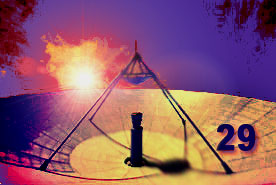
 to the homes of customers--and, thereafter we must assume, sold many
TV sets.
to the homes of customers--and, thereafter we must assume, sold many
TV sets.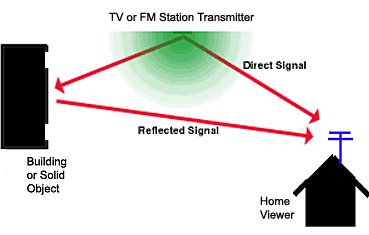
 cutaway view of the single copper wire inside.
cutaway view of the single copper wire inside. 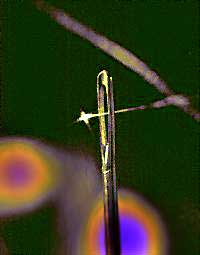 is fiber optics (also called optical fiber or OF) .
is fiber optics (also called optical fiber or OF) . 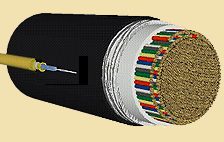 The information carrying capacity of OF is hundreds of times greater than a normal copper wire. (Note on the comparison in this photo between an optical fiber link and a telephone cable with hundreds of wires.)
The information carrying capacity of OF is hundreds of times greater than a normal copper wire. (Note on the comparison in this photo between an optical fiber link and a telephone cable with hundreds of wires.)
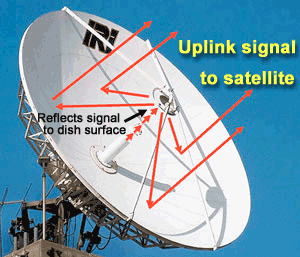 Geosynchronous satellites rotate at the same speed as the earth and end up being stationary in relation to the earth's surface. This obviously simplifies the job of keeping them within the range of both the uplink and downlink dishes on the earth.
Geosynchronous satellites rotate at the same speed as the earth and end up being stationary in relation to the earth's surface. This obviously simplifies the job of keeping them within the range of both the uplink and downlink dishes on the earth.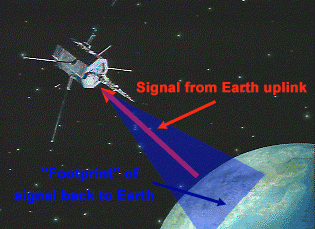 The signal from the uplink ground station is aimed along a precise path to the appropriate satellite.
The signal from the uplink ground station is aimed along a precise path to the appropriate satellite.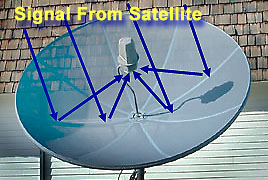 Within the footprint area receiving dishes work in reverse of the uplink ground stations.
Within the footprint area receiving dishes work in reverse of the uplink ground stations. are sent to the East Coast for network distribution.
are sent to the East Coast for network distribution.